Categories
-
Join 3,291 other subscribers
Who’s visiting
-

This work is licensed under a Creative Commons Attribution-NonCommercial-ShareAlike 3.0 Unported License. Meta
Week 3: Asking for help
Context:
This was the week we were supposed to come back to school after spring break. We didn’t. And so this is the week where we start the transition to really being deliberate in our planning for online learning. It felt less temporary. Which was scary.
The Big Idea: Ask for Help…But how
We heard a lot from teachers that kids weren’t asking for help. And kids weren’t turning in some of their work. Those two things seemed related for MANY kids.
We kind of realized that kids weren’t always good at asking for help. Some were so used to teachers checking in they didn’t know how to be proactive. Other kids were ashamed. Other kids were so worried about their teachers that they didn’t want to bother them. We needed to normalize asking for help. So we provided sentence starters for the kids to use in emails, googlechats, etc.
I have a question…
I don’t understand _____, can you help me?
Is there a good time to chat?
I know you have told me, but I’m still confused about ____
What do you mean when you say _____?
Can you remind me where in the instructions it says_____?
I am feeling overwhelmed….
I don’t know where to start….
I don’t think I can get all of this done. Are there other things I can do….
I am trying really hard, but I am struggling….
Can we talk?
Big Reflection Months Later:
This is something we will come back to throughout the Continuous Learning Program. Kids of all sorts refused to send an email or a google chat message asking for clarity. Some because of pride. Others because they were scared. Some because they couldn’t be bothered. But without being able to see their faces look confused or see their work when they get stuck, teachers were at a loss of how and when to help.
And in reflecting I walked away with more questions than answers. When do we teach kids how to ask for help? Asking for help is such a humbling process, how do we create a safe environment for this? How do we get the shy kid or the perfectionist kid to reach out?
Taking Forward:
An unwillingness to ask for help was something that was seen in almost all populations of our students. It was such a universal stumbling block for our kids that it should be something we teach when we are face to face or online.
I think we need to figure out how to create spaces where kids can safely struggle and stumble. They need a time and space where they can be proactive in asking for help. This can be in more flexible timetable or a more personalized learning. If students are moving at a different pace than all the others they are going to have to learn how to be proactive in asking for help.
Unseen Struggles
At the end of week 2, we were starting to see kids “fall behind” on their work. This would start a process of highlighting kids of concern and myself or the counselor reaching out to see what was up. There were some kids that through this process that I would start to worry about immensely.
Stray Thoughts
The wavy blobs on the slides seemed to match the mood of week 3. Everything felt nebuous and ever changing.
Posted in Uncategorized
Leave a comment
Week 2: Continuous Learning – Ask for Help…But Be Confident
Context:
At this point we had been doing Continuous Learning for four days. We only thought we had five more days to go. I was still going into school, as were a number of teachers. Because there was still some face-to-face interaction, there was still a lot of informal conversation about what teachers were seeing. It was easy to see what some of the big struggles would be: organization and well being. These would remain as areas of focus for next four months.
The Big Idea: Ask for Help…But Be Confident
We had three types of kids in middle school online.
- The ones doing okay. Asks questions sometimes, makes mistakes, but in general doing okay. To be honest, most kids fit into this one.
- The questioner. Asks a lot of questions. Needs a lot of virtual support and positive feedback. Very very afraid of making a mistake.
- The Ghost. Gets lost or confused, but refuses to ask teachers for help. So got even more lost. Often ignores emails, googlechats, etc. These are the one that took the most time.
This week we tried to speak to all of them. To give positive reinforcement to the ones figuring it out, to empower the kids who felt lost without constant teacher feedback, and to invite kids to ask questions.
Big Reflection Months Later:
I wish I had been more proactive somehow with The Ghosts. We saw them very very early in the Continuous Learning Program. I wish we had set up more intentional teams, including parents, as soon as we saw them ghost. I don’t think we needed to wait until they start missing work.
Taking Forward:
This video talks a lot about organization, self-management, and self-advocacy. I’ve really been thinking that schools need to build some sort of flex time within the school day where kids are free to move around, create their own schedule, seek out help, and do all the things they did while campus is closed. While we can teach organization within the context of a traditional classroom, the gap between that and Continuous learning is huge. So many kids have proved that they can handle this freedom. Other kids have proved they need more practice with the freedom with a more secure safety net.
Unseen Struggles
“Some of you are working waaaay more than we expect you to”.
Trying to figure out how long it takes a student to do a task is close to impossible. In class, we adapt. We make individual accommodation, we change the deadline, we stop a lesson to go down an interesting tangent.
Understandably teachers really struggled with how long a task would take online. So we started with positive intentions of all teachers:
- Everyone wants our students to learn, to be happy, and to be healthy.
- We are assigning tasks that seems reasonable, but the kids are stressed
- We are assigning work, but it’s hard to tell how much time it’ll take
- The students want to do well on the work we are assigning, but they keep asking me to repeat the instructions. Again and again. And again
- I’m doing all of this work, but some kids aren’t doing what is expected.
Once we had these expectations, we created this slideshow to provide some structural, pedagogical, and practical support. It was amazing how much teachers adapted their practice to the needs to the kids, thought their own hard work, collaboration and learning.
Stray Thoughts
As teachers saw organization being a roadblock for success they started to create and share work to support student learning around this topic. Big thanks to Amanda for creating this awesome poster. Pro-tip – get your art and design teachers to create awesome things!
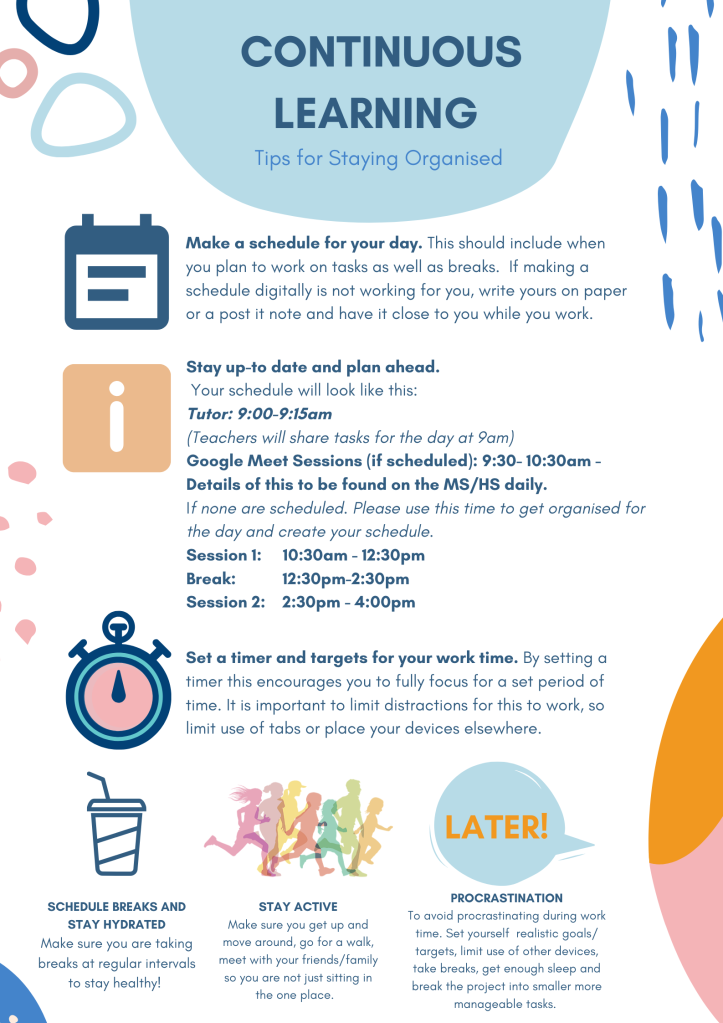
And Tina for creating this Daily Agenda.
Finally…
At the end of Week 2 was going to be our Spring Break. Never has a Spring Break been so welcomed.
Posted in Uncategorized
Leave a comment
Week 1 Continuous Learning: Same Same But Different
Context:
We started Continuous Learning thinking it would be a two week thing. Ha! It ended up being 13 weeks. But so many things that we started in this week laid the foundation for the entire Continuous Learning experience. Teachers had two days of professional learning and were ready (kind of) to go. But this video was the first time the kids and parents really heard what the learning would look like.
I started making these videos on a whim. I just know middle school don’t read all the things. But maybe if they heard me talk a critical mass would know what is up.
The Big Idea: Same, same but different
The way we introduced this kids was helping them realize that being online has similarities to being in school. We really wanted the kids to feel confident as they started learning online. The similarities included 9AM morning tutor, using Google Classroom, using school appropriate language, teachers are there for you, asking for help. We knew things would be vastly different, but it was vital that the kids felt secure in some things. So we stressed with kids (and teachers) that somethings stayed the same…we were YIS and would continue learning even if we closed school.
Big Reflection Months Later:
The very best decision we made was making sure every single morning started with morning tutor (you might call it homeroom or advisory). One — it provided a reason to get out of bed every morning. Secondly, morning tutor became a home base, a community, and a place to figure things out for the day. And the nine tutors ended up being superheroes throughout the weeks of campus closure. No matter how messy things got or how how disengaged kids may have become, the kids turned up to tutor every morning.
Taking Forward:
The tutor program is key. I think like most schools, we are realizing moving forward we need a culture of voice and choice…kids can handle it and we don’t know when the next emergency situation will happen. And if we want to do anything in terms of flexible time or personalized learning, it’s important that kids have someone who knows them. Tutors challenged some kids, supported all kids, and bent over backwards to make sure no kid got lost in the shuffle. As we move forward, it’s imperative that we develop skills of tutors, increase collaboration between tutors, and give tutor time the time it deserves.
Unseen Struggles
We really struggled to figure out balance between synchronous and synchronous sessions. We started with only morning sessions and then independent work time rest of day. Many people wanted more sync sessions, as that felt the most similar to what we were used to. We would continue to tweak this throughout the CLP…but we did know that being online 9-4 wouldn’t work for teachers or kids. We would need to increase professional learning that would support asynchronous learning and probably something we could continue to focus on.
Stray Thoughts
I think I started doing this and caring what my hair looked like and what I was wearing. My nails are manicured. We will witness a decline in pride throughout the next 13 weeks.
Finally…
I ended the video saying, “we can’t wait to see you after spring break”. Poor innocent vice principal…
Posted in Uncategorized
Leave a comment
An update and the plan: Reflecting on Continuous Learning and Thinking Forward
So it’s been a long while since I’ve blogged. So long I have a “follow me on Google+ button” on my site. And a lot has happened since I have last logged in to add some ramblings.
I’m now a vice principal and MYP coordinator. I’ve gone through a learning curve of becoming a senior leader. I’ve gotten lost in GoogleDocs, meetings, professional learning. And I’ve learned a lot and I get to work with some amazing people. I’ve love being a school leader, but I wasn’t sure of what my voice would be if I blogged. And to be honest, I didn’t have the space (calendar or brain wise) to really share my learning publicly
And this year, COVID-19 hit. For 13 weeks we closed campus and all learning happened as part of our Continuous Learning Program. Online. From the relative comfort of our homes teachers, students and leaders learned how to learn without the ease of common spaces and times. And I finally feel the desire to start sharing again because I don’t want to forget what I learned in this crazy time.
Here is the plan….
Every week for the 13 weeks we had a closed campus I sent a video to my middle school students, parents, and teachers. I’m going to use those videos a prompts to remember what was important in our learning as we adjusted to this weird time. And I’m going to try to remember what decisions we made, why we made them, and what lessons I want to take forward to next year and beyond. We don’t know what next year will bring, but I know there was some serious learning that happened last year and I don’t want to forget it before the madness begins again. I’ll be blogging from my perspective and what happened in the middle school, but it should go without saying that nothing here I did on my own…I would have lost my mind without the support and hard work of so many other people.
It won’t be fancy, but I’ll try to be honest. And as always, I’m blogging for me. But feel free to read along.
Stay Safe,
R
Posted in Uncategorized
Leave a comment
Breaking it down
My assessments are full of text. And not fun text…boring text. Sometimes I try fun fonts or pretty colors or a thought-provoking pictures. But there are a lot of words. Seriously…look at this grade 6 assignment.
But it’s never the most entertaining. But it is important.
I’ve been using the sequencing brainframe* to help my kids break down what they need to do. Sequencing brainframe basically is a story telling device. First you do this then you do that.
Sometimes my brainframes are done online. This one was for our grade 7/8 2 day project based learning days and broke down the steps for the kids would do when working independently.
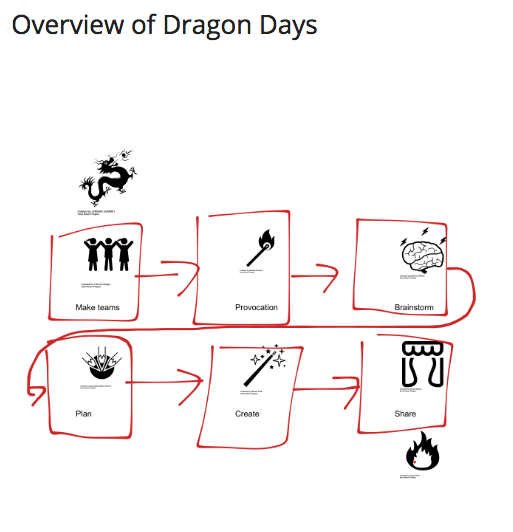
Sometimes I do them very neatly and post them on my blog. This one is for my grade 6 early man skits.
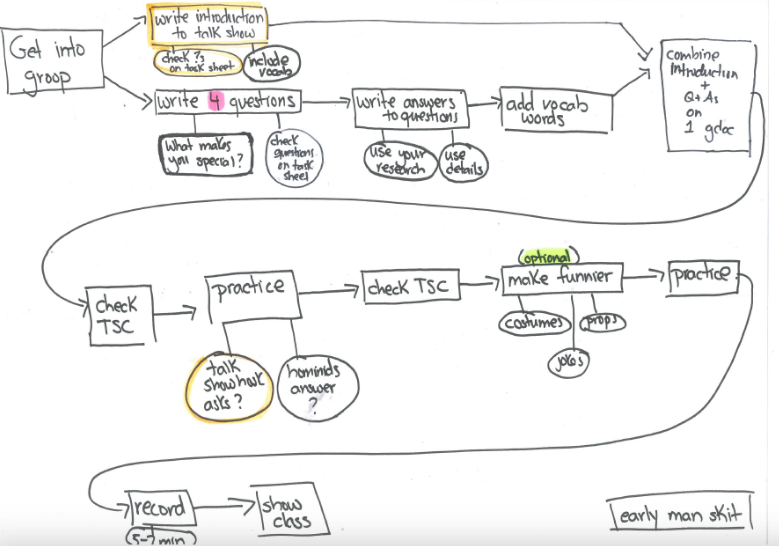
Most of the time I just quickly do it on the whiteboard and take a pic at the end of class. This one is for my grade 7 empires timeline.
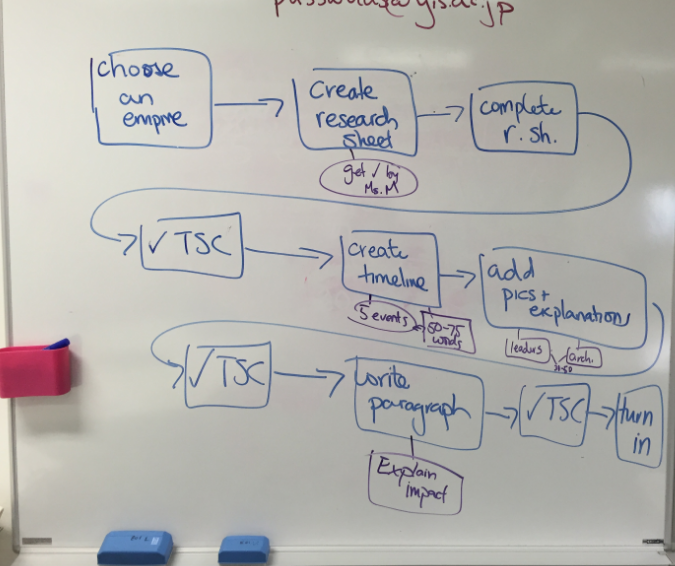
Or my grade 7 Child Labor Trial, with the days written down for when they should finish each step.
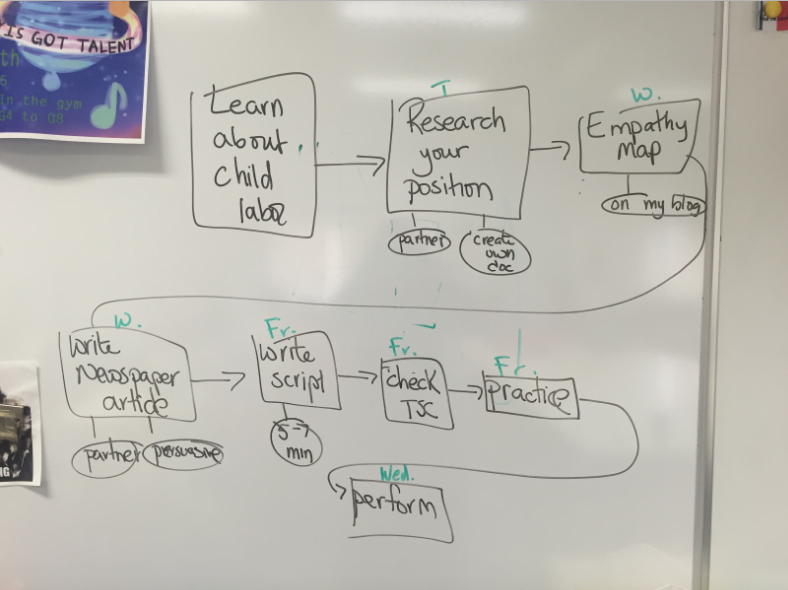
This helps my kids SEE the steps. It also helps my kids CHECK that they have all the required bits of our pretty big assignments. And when I add the “check the TSC” (our word for rubric)” along the way it ensures that my kids are REFLECTING on their work
The final step is have my kids take all the text and make their own sequencing brainframe. Stay tuned for how that goes…
*brainframes are flexible visual organizers that help students visually communicate their understanding and their thinking. See Architects for Learning for more information about how they work.
Posted in Uncategorized
Leave a comment
Helping teachers learn
One of my hats is “In-School Professional Development Leader”. Basically, I help shape what professional learning goes on in school, be it through meetings or structures for learning through teacher evaluations. As I get ready to actually plan 2016/17 professional learning for YIS teachers, I’ve been reading Dylan Wiliam’s new book “Leadership For Teacher Learning: Creating a Culture Where All Teachers Improve so That All Students Succeed. Before I went off this and starting worrying about logistics of planning faculty meeting I wanted to reflect on some of the points Wiliam brings up.
I have been at staff meetings where I’ve considered if it would be less painful to stick an icepick in my ear rather than stay and listen to one more thing. Every one of these memes resonates for me.
And now I’m the person organizing Monday morning meetings. With the admin team, I help shape what professional learning looks like at YIS. It’s a hugely challenging/fun job. And I work really hard for the meetings to be learning experiences, not a rehash of what could have been said in an email. But I know one is that happy to receive an email from me reminding them of Monday’s meeting. Even me, some days, if I’m honest.
So as I get ready to plan next year’s professional learning plan, I wanted to put some quotations from Dylan Wiliam and do some reflection before I start working.
“Once the “what” of teacher professional development is clear, then the focus should turn to the “how” of professional development, and in particular, the process of teacher learning should be tailored to the focus of teacher learning that has be identified as a priority.”(p164)
It seems obvious that the “what” should be improving student learning. But what that means is more difficult to assesses. And sometimes I get so focused on the logistics and the plan and choosing the exact right activity to do with teachers, that perhaps I don’t communicate the focus on student learning as clearly as I should. So when I start planning…I’ll start with the “what” rather than the “how”.
“The aim of professional development is not to make everyone a clone of every other teachers, but rather to support each teacher in becoming the best teacher he or she can ben. Teachers are often their best when they are their quirky idiosyncratic selves and that is why choice is so important” (p168).
I love this quote. One of the reasons I love YIS is that it does embrace the quirky. Professional Learning needs to allow teachers to be themselves and play to their strengths. At international schools, where people come from many different backgrounds, this may be especially true. But that said, I do think all teachers can improve. But improvement can and should look different for every person.
“Teachers have to make small incremental, evolutionary changes to their practice…only a small numbers — ideally one or two, and certainly no more than three –aspects of their practice at one time” (p 175)
It’s probably no surprise for anyone who knows me, but I like to go full steam ahead. But that isn’t really what is best. Change in school is evolutionary, which can be so frustrating when I want change RIGHT NOW. But I need to take a breath. The best example I can think of this is how much I want to introduce data collection and analysis into how we think about professional learning. I think there is a lot of value of knowing if what we are doing is having an impact on learning. I think I was ready to do that next year. But I’m realizing that is a long-term project and I need to create the circumstances for that to evolve so that it sticks at YIS for a long time.
“Teachers may, of course, chose to engage in research on lesson study [or}…learning styles… [etc] if they choose to do so, but that should be outside their contract. In contractually committed time, teachers should prioritize what makes the most difference to the students” (p 177)
This one has really got me thinking. As an inquiry based school, we value teacher and student inquiry. Our Professional Learning Plan is basically a year-long inquiry into a topic of teacher interest. Nine full faculty meetings are put aside for people to work on their inquiry…..that is a lot of time AND money our school puts towards this type of learning. I believe passionately that teachers need to have ownership of their learning and the best learning happens when people choose to construct meaning for themselves. I’ve seen great things happen when teachers choose what to study…even if it’s not what I would have chosen. So trying to balance teacher inquiry with practices that best serve the students (even if it’s not what the teachers would choose) is an interesting one that I need to think more about.
Posted in Professional Learning, Uncategorized
4 Comments
What my students taught me on their last day of school
Today was the last day for my grade 12s. They are going away to take their exams. I’m a little sad. Actually I’m a lot sad, because I’ve spent two years with these people and after today I won’t see them every day. I love teaching middle school, but there is something special being part of this literal commencement of adulthood. My smart, funny, refuse-to-focus, history dorks* are ready to leave me.
Today the grade 12s took over the school. Senior pranks at YIS are so silly. They ask permission for each prank. They steal chairs and takeover the staff lounge until 9AM and no later. They make grade 1 students pretend to be IB students. They photoshop teachers as professional basketball players and as Churchill. Silly, funny, thoughtful pranks**
So today I came to my room this morning and I saw this and laughed…
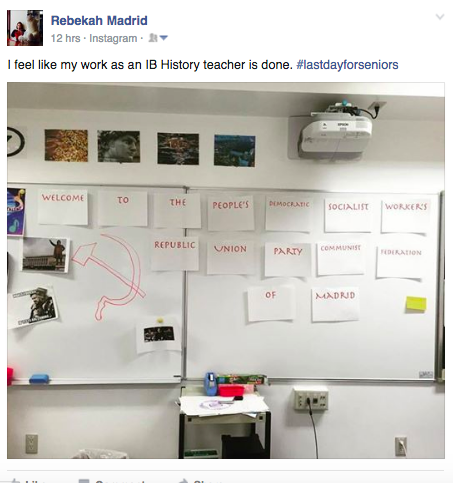
And I saw this and laughed…

And I saw this and I was hit in the gut…
Grade 12 feminist critique. And, sadly, they're being over generous. pic.twitter.com/Q8Dw2P3R0d
— Rebekah Madrid (@ndbekah) April 26, 2016
//platform.twitter.com/widgets.js
I laughed all day at this. It’s just so biting and mean and true. The women of my class are so damn smart***. But then I thought about it. What type of teacher/feminist am I when women aren’t the heroes of history, at least sometimes? Why do we basically have a celebration every time we learn a woman’s name or read a history book written by a woman? Why are we studying what happens to women as opposed to understanding how women can take control of history?
I can make excuses. I know exactly why I teach what I do and there are legitimate reasons, too boring and pedantic to discuss here. But the wonderful women of my history classes deserve more. The men in my class deserve to know that studying women is valid and important.
I’m now trying to figure out how to add something women to the syllabus for next year’s students, because they deserve more too. My gorgeous grade 12s, these special men and women, totally schooled me on their last day at school. They inspired me to be a better teacher. As it should be.
—————————————————————–
- I call them dorks, lovingly, on a regular basis. My wall of memes they sneakily post proves my thesis.
- Sometimes they are so sweet that I legitimately worry about them when they leave YIS. Are they tough enough?
- I know it was the women because I talked to them.
Posted in Uncategorized
3 Comments
Learning in the 10th Circle of Hell: Learning at the Middle School Dance
Here is my talk from Learning2 Manila. Thanks for letting me have the stage, Learning2. I’m realizing how much fun it is up there!
Watch this talk if…
….you have 8 minutes to spare and you’re running out of internet to read
… you have memories from your middle school dance and need to find a like-minded community
…watching adults awkwardly dancing to Boyz II Men makes you happy
…you think middle schoolers are resilient, amazing people.
Posted in Uncategorized
Leave a comment
Project One School: Empowering Kids Two Days at a Time
I’m behind. I have about 10 blog posts I need to write. But my words all seem to be going to other spaces…Coetail blogs, report cards, emails. All those places words go. But I’m blogging now. And that’s my little victory for today.
I’m starting this off with the statement that this wasn’t my project. I was there for support. And ideas. And feedback. And support. But this entire project was the brainchild of Cari Barbour, English teacher extraordinaire. But I did want to blog about it, so I don’t forget.
The Germ of an Idea: Where did this idea come from?
- Where: At the EARCOS middle school conference
- When: 2 days in May 2015
- Who: A bunch of middle school teachers from YIS. Just having the group of teachers with time to talk and laugh meant that we could make something happen
- What: Could we take our middle school kids off of timetable for a project based learning week?
First Prototype: What did we first think would happen?
- Who: All middle schoolers in mixed grade teams
- When: One week at the end of the 2015 school year. Beacause we don’t do anything
- What: Students would create something based around something that interested them. Students would be grouped around themes like “Arts” “Sports” or “Service” We would include sessions about Approaches to Learning.
It was pretty obvious from the first discussion this was a step beyond where we actually were. A week was too much time. The idea of something was too vague. And we were too tired to actually make it happen.
Second Prototype: What we actually did
- Who: Grade 7 and 8s in placed in mixed grade level small groups

- When:
- First day of school (August 24) we start with ideation phase
- A month of challenges for the groups to complete independently. Coming up with a team name, team logo, take a picture, etc.
- Sept 17 and 18 – all students off timetable working on prototyping, pitching, practicing.
- What: In your groups you will design, organize, and present a new idea to bring together a new idea to bring YIS together.
- How: The three winning pitches (who met the criteria according to three judges) will be funded by a PTSA grant (thanks PTSA!)
Resources:
So you want to run your own PBL days and you want to steal some stuff (please do! And then share how you made it better!)
If you want to see what things actually looked like, check out the Project One School googlesite. This was the resource the kids had and you can see the schedule for the day, what skills they kids worked on, and information about the idea of the pitch and the rubric for the most successful pitch.
- Reflection:
- It was amazing. You should do it at your school. Kids are fantastic and they always step up. They handled the freedom of being off timetable, with minimal teacher supervision, with responsibility and a sense of pride.

- Teach your kids how to do action plans. It’s worth it, even though it sounds boring. At leadership day last year, a bunch of kids were introduced to an action plan and used it to plan events and activities. And with the kids in lots of different groups, there was at least one “expert” who could help the kids create a two day action plan. And now kids are using for dances or for GIN-CAS concerts, etc.
- I loved watching kids go and talk to people they don’t normally talk to. They interviewed the principal. They found the service learning coordinator. They interviewed grade 3 kids. They surveyed high school kids. It was a great way to get people talking and letting the kids take the lead. When do our kids have the opportunities to do this.
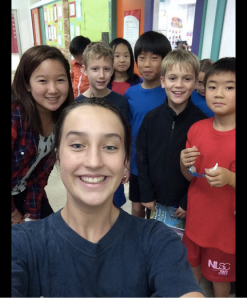
- We need to involve more teachers. I think there was a core group of people who knew (kind of/sort of ) knew was going on. We need more teachers involved next year.
- Even though kids were off-timetable, logistics were still a nightmare. How is that even possible? Each group had a logistics manager…they needed to know where there was supposed to be and when.
- Do brain breaks. We had one kid in each group lead people with brain breaks.
- There were stakes and they were very real. Every group had to present. Everyone had to contribute. There was a winner. This was negotiable. This is vital to giving energy to the days.

- Kids were practicing all the skills we want them to: Creative commons presentations. Public speaking. Collaboration. Making connections between classes. Collaboration. Collaboration.
- Here are the kid’s reflections. If it’s possible for a google form to be entertaining, this might be it.
- Process is more important than product. Do I really need to expand?
- It was amazing. You should do it at your school. Kids are fantastic and they always step up. They handled the freedom of being off timetable, with minimal teacher supervision, with responsibility and a sense of pride.
Next Steps:
- 3 groups won. They now have mentor teachers and are working towards getting it done
- Normal Narwals T-Shirt Project: Presentation and Budget
- Wonkers and Co. Art Workshop: Presentation
- To Infinity and Beyond: YIS Got Talent: Prez
- Non-winning presentations may still happen. You don’t have to win to bring the school together.
- We will do it again. Bigger and better. Stay tuned
What an amazing two days! As @ndbekah said, this photo says it all! #yisoneschoolhttps://t.co/uKXmbjecVg
— Cari Barbour (@caribarbour) September 18, 2015
—-
Posted in Uncategorized
Leave a comment
That’s a tomorrow problem

flickr photo shared by Drriss & Marrionn under a Creative Commons ( BY-NC-SA ) license
Two inherent truths about myself:
- I love sleep
- I dislike stress
I wear a lot of hats. I think all teachers do. And I’m always so excited to say “yes”. All of my “yes” moments are intrinsically motivated. I love trying new things, being part of a solution, and I want to avoid falling into a rut. But along the way, I’ve found myself sometimes struggling to balance all of the hats I’ve chosen to wear. And that leads to stress. And that leads to less sleep. Which has meant that I’m not honoring the two to truths about myself. So I’ve tried a few things to help this year. Some are simple (Wunderlist has saved my life and the first app I’ve ever liked as a to-do list). Some are lifestyle choices (Headspace to help with mediating is really a special thing). But the biggest one for me is scheduling my worry.

The answer was somehow both.
Designated Worry Time
Every morning when I get to school, I look at my Wunderlist and have a tiny panic attack. And then get busy scheduling when I will worry about the things on my to-do list*. It could be I’ll worry about it in March. It could be period 3 tomorrow. When I get an email, I mentally think about when I can worry about it. Sometimes I put the worry time in my calendar. Or I tell people “that’s a Thursday problem, but I promise to get to it then”. Or I have designated days to worry about a particular project.
And here is the secret:
I don’t worry about it until I’m schedule to worry.
Quick case study:

flickr photo shared by photosteve101 under a Creative Commons ( BY ) license
I teach DP History and it is often the class that takes most of my time in planning and grading. I received a long email from my DP coordinator with the details of uploading my internal assessments in three weeks time, which also happened to be the week grades were due and we had Student Led Conference. Normally this work have me immediately responding, emailing and dropping all other things to get it done as soon as possible and me stressing about all of the things that seemed to be due at the exact same hour. Instead what I did was send the email to my Wunderlist and didn’t think about it for 10 days, when I knew I had a day with a low teaching load and most of my grading would be done. I would occasionally think about it, but I knew I had time to deal with it later. And I slept pretty good that week.
Why this works for me
Having been using this system this school year, there are a couple of side-effects to this (both positive and negative)
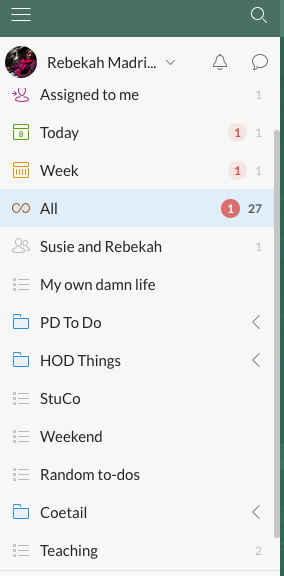
I created the category “my own damn life in a moment of frustration last year. This year it makes me laugh.
- I am active as opposed to be reactive. I don’t have to jump with every email. I don’t have to respond to everything. I will get to it when my schedule says I can.
- I’m using my time wisely. As opposed to spinning around my googledocs like a virtual Tasmanian Devil, I know what I’m doing because I’ve planned it. And I’m not jumping from project to project because I know I have time scheduled for everything. And now I’m no longer worrying, but I’m thinking.
- I’ve started long-range planning. I’ve prioritized many of my projects, put them in a Googles spreadsheet and indicated when I’m going to think about it. In doing so I realized I was planning on doing a lot of big picture thinking in March. This isn’t going to be feasible because of the fact that I’m traveling and grades will be due. So I figure out when I do have time to worry about those big projects.
- It seems like I’m avoiding things, but I promise I’m not. One of my biggest flaws is actively ignoring things I don’t want to do. But by honoring my time, I actually know I am going to do something I don’t want to do.
- Things come up. We work in a school and things will come up. There are days where my plans will be thrown out the window and something needs to get done right now! But that’s okay. And sometimes something will take longer than expected. And that’s okay too. I will have weeks where things will be intense and I will worry and stress and maybe my to-do list will be running through my mind at 2AM. It happens. But it will get done.
- I’m vaguely afraid that by posting this post I’m jinxing myself I can imagine 20 emails coming in 30 minutes after I post and I will regret ever hitting publish.
- Sometimes, people won’t get what they want from me right away. This is a toughie for me. I don’t like to say no. I don’t want to do less than 100% for my students and do less than my best in the jobs I’ve already said yes to. I love to dive in. But my life is a delicate balance and sometimes I have to tell someone I can’t do it right now. But I promise to worry about it later. And if I don’t have time to worry about it, maybe I will just have to say no (gulp!)
Of course this won’t work for all people. But it works for me. And having been working on this this year, I feel healthier and more balanced. And most importantly, for everyone around me, I’m back getting my full 8-9 hours of sleep.
————————-
*There is something much more formal based in Cognitive Behavioural Therapy called designated worry time. My system isn’t quite that, but it’s not too far off.
Posted in Uncategorized
Leave a comment





